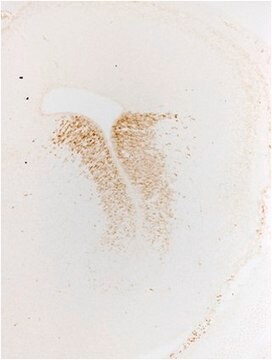AB1511
Anti-Glutamate Decarboxylase 65 & 67 Antibody
Chemicon®, from rabbit
Synonym(e):
65 kDa glutamic acid decarboxylase, Glutamate decarboxylase 65 kDa isoform, Glutamate decarboxylase-2 (pancreas), glutamate decarboxylase 2, glutamate decarboxylase 2 (pancreatic islets and brain,65kD), glutamate decarboxylase 2 (pancreatic islets and br
About This Item
Empfohlene Produkte
Biologische Quelle
rabbit
Antikörperform
saturated ammonium sulfate (SAS) precipitated
Antikörper-Produkttyp
primary antibodies
Klon
polyclonal
Speziesreaktivität
mouse, feline, rat, human
Hersteller/Markenname
Chemicon®
Methode(n)
immunohistochemistry: suitable
western blot: suitable
NCBI-Hinterlegungsnummer
UniProt-Hinterlegungsnummer
Versandbedingung
dry ice
Posttranslationale Modifikation Target
unmodified
Angaben zum Gen
human ... GAD2(2572)
Allgemeine Beschreibung
Spezifität
Western blot reveals a doublet at approximately 65/68 kDa.
Immunohistochemical staining can be abolished by preincubation with 1-10 μg peptide (Catalog Number AG252) per mL of diluted antibody.
Immunogen
Anwendung
Neurowissenschaft
Neurotransmitter & Rezeptoren
Neuronen- & Gliamarker
1:200-1:5,000 dilution of a previous lot was used in immunohistochemistry (overnight PAP or ABC). Several fixative solutions may be used. Aldehyde-combination fixatives (i.e. those containing formaldehyde and glutaraldehyde) usually give satisfactory results. Bouin and Susa fixatives containing 0.1-0.2% glutaraldehyde have been used satisfactorily. Also reactive on paraffin embedded tissue. Protease digestion is not required.
Optimal working dilutions must be determined by the end user.
Qualität
Western Blot Analysis:
1:500 dilution of this antibody detected GAD 65&67 on 10 μg of mouse brain lysates.
Zielbeschreibung
Physikalische Form
Lagerung und Haltbarkeit
Handling Recommendations: Upon first thaw, and prior to removing the cap, centrifuge the vial and gently mix the solution. Aliquot into microcentrifuge tubes and store at -20°C. Avoid repeated freeze/thaw cycles, which may damage IgG and affect product performance.
Hinweis zur Analyse
Whole rat brain lysate, mouse brain cell extract.
Sonstige Hinweise
Rechtliche Hinweise
Haftungsausschluss
Sie haben nicht das passende Produkt gefunden?
Probieren Sie unser Produkt-Auswahlhilfe. aus.
Empfehlung
Lagerklassenschlüssel
12 - Non Combustible Liquids
WGK
WGK 1
Flammpunkt (°F)
Not applicable
Flammpunkt (°C)
Not applicable
Analysenzertifikate (COA)
Suchen Sie nach Analysenzertifikate (COA), indem Sie die Lot-/Chargennummer des Produkts eingeben. Lot- und Chargennummern sind auf dem Produktetikett hinter den Wörtern ‘Lot’ oder ‘Batch’ (Lot oder Charge) zu finden.
Besitzen Sie dieses Produkt bereits?
In der Dokumentenbibliothek finden Sie die Dokumentation zu den Produkten, die Sie kürzlich erworben haben.
Unser Team von Wissenschaftlern verfügt über Erfahrung in allen Forschungsbereichen einschließlich Life Science, Materialwissenschaften, chemischer Synthese, Chromatographie, Analytik und vielen mehr..
Setzen Sie sich mit dem technischen Dienst in Verbindung.








